
The Partnership for Advancing Technology in Housing (PATH) announced their updated list of the 10 top technologies that are job-site tested and ready for implementation. PATH selects technologies based on their ability to improve one or more of the following areas: durability, affordability, energy efficiency, environmental impact; safety; and disaster mitigation. For more information, go to www.pathnet.org.
Top 10 Technologies for 2007
1. Mold-resistant drywall has a glass-mat facing or a chemically treated paper facing for mold resistance. Regular drywall has a plain paper facing.
2. Solar water heating can cut water-heating bills up to 75%. Federal tax credits can save you 30% of the installation costs, up to $2000.
3. Recycled aggregate in concrete cuts the amount of sand and gravel that need to be mined out of the ground while creating a use for industrial waste or solid waste. Substitutes include coal ash, blast-furnace slag, fiberglass, and plastic.
4. Combined heat and power (CHP) systems generate power from the same fuel used to heat a house, and they’re extremely efficient, about 90% (central power stations are about 35% efficient). Micro-CHP systems for houses can generate 1kw to 6kw of power.
5. Single-unit washer/dryers are front-loading machines that wash and dry clothes. They save both water and energy compared to standard separate units.
6. Hydrophilic, impact-resistant windows shed water faster and repel flying projectiles better than standard impact-resistant glass. A silicondioxide coating makes glass smoother, allowing water molecules to wash away in sheets. Impact resistance is boosted by laminating the glass with composites that, according to PATH, “provide enough strength to allow windows to withstand high winds, projectiles, or even bullets.”
7. Supersize (vertical) insulating concrete forms (ICFs) are like regular ICFs, only bigger and with fewer joints, making assembly faster with less bracing needed.
8. Induction cooktops heat the pot instead of the stovetop. In doing so, they use less energy and are much safer if you tend to forget the stove is on.
9. GPS for land development brings digging a hole into the 21st century. A machine interface, operator interface, and some sensors communicate with each other via a satellite-controlled GPS device to provide accurate information to the machine operator about cutting depth and location in relation to the design grade. No stakes needed.
10. Permeable pavers and pavement take a load off storm drains and reduce pollution. When rain runs off a roof, into the street, down a storm drain, and into a lake, the lake becomes dirtied by asphalt, tar, oil, and other pollution along this path. When rainwater is allowed to percolate into the soil, it’s cleaned the old-fashioned way, with soil microbes.
Photo by Chris Ermides

























